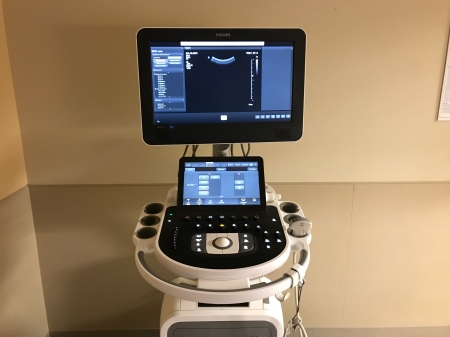
Overlook Medical Center’s vascular lab has helped pioneer the diagnosis and treatment of fatty liver disease using a combination of FibroScan® (transient elastography) and portal duplex ultrasound. The Vascular team at Overlook Medical Center can identify fatty liver disease in its earliest stages aiding physician’s treatment plans.
Overlook Medical Center recently announced our newest ultrasound scanner, the Phillips Epiq Elite. This scanner includes ElastQ elastography, which uses a stiffness and confidence map to obtain accurate stiffness readings.
As Clifford Sales MD, Medical Director of vascular lab and Chief of Vascular Surgery at Overlook Medical Center, explains , "A portal duplex with elastography exam uses ultrasound technology in innovative ways to create a comprehensive, non-invasive test of the function of the liver and surrounding vasculature."
Fatty liver disease is an over-accumulation of fat in the liver and can progress to severe liver diseases including cirrhosis (severe scarring of the liver). In the US alone, between 80 and 100 million people suffer from fatty liver disease not related to the consumption of alcohol. Liver disease is more prevalent today than in years past; sedentary lifestyles and contemporary diets, certain diseases and medications are known contributing factors.
Many sufferers dismiss the symptoms of fatty liver disease as common aches and pains of everyday life. However, ignoring its signs and symptoms can adversely affect the future quality of life and, in severe cases, even lead to death.
Symptoms of fatty liver disease include a plethora of common ailments, including acid reflux, trouble focusing, fatigue, and loss of appetite.
As symptoms worsen, they can include:
- Abdominal pain and bloating
- Pale, bloody, or black stool
- Itching skin
- Vomiting
- Weight gain
- Difficulty breathing caused by fluid buildup
- Lower extremity edema
- Jaundice
- Pulmonary hypertension
- Caput medusae (large, visible veins in around the abdomen)
- Seizures
FibroScan® is a painless, non-invasive test that can not only identify the earliest stages of the disease, but also those patients who are most likely to develop clinically significant liver disease. Moreover, the first exam establishes a baseline that can be used to track the effectiveness of treatment and the progression of the disease.
A portal duplex ultrasound assesses the vasculature of the liver, spleen, and connecting vessels. It measures the diameter of the vessels, the speed of the blood’s flow, its direction, and more.
Taken together, these give a complete picture of the function and health of the liver.
If you suffer from any of the common symptoms of fatty liver disease, ask your health care provider about the benefits of a non-invasive portal duplex with elastography exam.